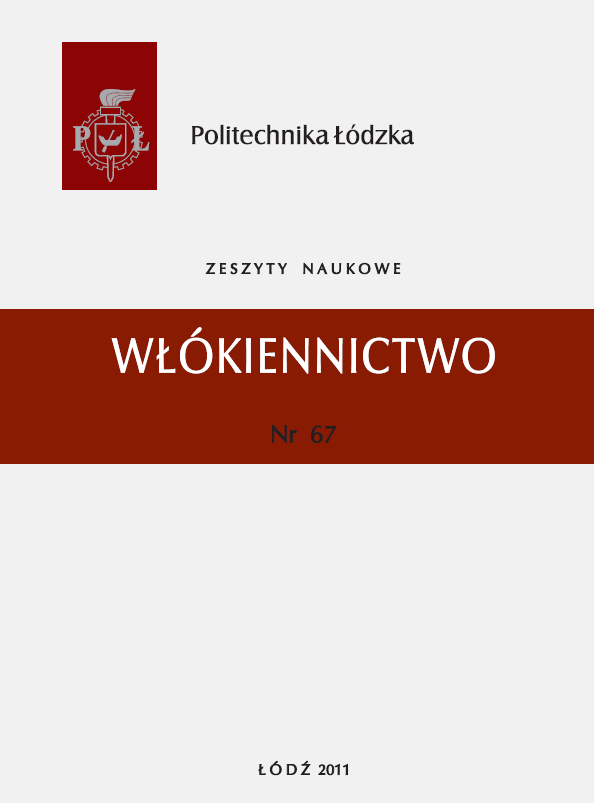Abstrakt
Celem podjętych w pracy badań było opracowanie nowej, oryginalnej metody otrzymywania wykończeń antymikrobowych poprzez tworzenie nanocząstek srebra „in-situ”, na i w tkaninach bawełnianych. Wybór tkanin bawełnianych był podyktowany ich dużą hydrofilowością oraz tym, iż zawierają w swojej strukturze tzw. puste przestrzenie (zarówno we włóknie, w przędzy jak i w płaskim wyrobie włókienniczym), umożliwiając w ten sposób wykończenie antybakteryjne tekstyliów z medium wodnego oraz wprowadzenie biocydu nie tylko na powierzchnię włókien, ale również do ich wnętrza. Unikalne właściwości, jakie wykazuje srebro w skali nano pozwoliły na uzyskanie wykończeń wykazujących właściwości biobójcze w stosunku do szczepów bakterii Escherichia Coli, Bacillus Subtilis i Staphylococcus aureus. Opracowanie sposobu nanoszenia biocydu za pomocą technik drukarskich umożliwiło miejscową aplikację nanocząstek srebra oraz produkcję różnych partii materiału w zależności od potrzeb. W pracy zastosowano szeroki wachlarz najnowocześniejszych technik badawczych, które potwierdziły, iż wykończenia te charakteryzują się nieznaczną migrację biocydu z wykończonego wyrobu tekstylnego podczas procesu konserwacji oraz długotrwałą odpornością na procesy prania, nieopisaną do tej pory w literaturze.
Bibliografia
Urbańczyk G.: Nauka o włóknie, Wydawnictwa Naukowo-Techniczne, Warszawa 1985.
Abu-Rous M., Ingolic E., Schuster K.Ch.: Visualisation of the fibrillar and pore morphology of cellulosic fibres applying transmission electron microscopy, Cellulose (2006) 13:411-419.
Wang D., An J., Luo Q., Li X., Li M.: A Convenient Approach to Synthesize Stable Silver Nanoparticles and Silver/Polystyrene Nanocomposite Particles Journal of Applied Polymer Science, Vol. 110, 3038-3046 (2008).
Amendola V., Polizzi S.: Free Silver Nanoparticles Synthesized by Laser Ablation in Organic Solvents and Their Easy Functionalization, Langmuir 2007, 23, 6766-6770.
Li D., Kaner R.B.: Shape and Aggregation Control of Nanoparticles: Not Shaken, Not Stirred, JACS Articles, Published on Web 12/31/2005.
Wang D., An J., Luo Q., Li X., Li M.: A Convenient Approach to Synthesize Stable Silver Nanoparticles and Silver/Polystyrene Nanocomposite Particles Journal of Applied Polymer Science, Vol. 110, 3038-3046 (2008).
Li D., Kaner R.B.: Shape and Aggregation Control of Nanoparticles: Not Shaken, Not Stirred, JACS Articles, Published on Web 12/31/2005.
Culha M., Kahraman M., Tokman N., Turkoglu G.: Surface-Enhanced Raman Scattering on Aggregates of Silver Nanoparticles with Definite Size, J. Phys. Chem. C 2008, 112, 10338-10343.
Moskovits M.: Adsorbate-Induced Silver Nanoparticle Aggregation Kinetics, J. Phys. Chem. B, Vol. 109, No. 31, 2005.
Egorova E.M., Revina A.A.: Optical Properties and Sizes of Silver Nanoparticles in Micellar Solutions, Colloid Journal, Vol. 64, No. 3, 2002, pp. 301-311. Translated from Kolloidnyi Zhurnal, Vol. 64, No. 3, 2002, pp. 334-345.
Briggs D., Seah M.P.: Practical Surface analysis by Auger and X-ray Photo Electron Spectroscopy. John Wiley & Sons, Chichester-New York-Brisbane-Toronto-Singapore 1992.
http://srdata.nist.gov/xps/WagnerPlot.aspx
Hesse R.: Line Positions and Data Formats XPS – Version 2010, Unifit Scientific Software GmbH.

